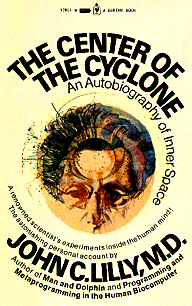|

CHAPTER 04
Following Instructions and Going with the Flow
|
exposed to the repeating word stimulus, I found that certain people
went through various kinds of trips. In one audience of two hundred
people, we found that something like 10 to 12 per cent of the people
tripped out and did not report anything about the alternates that they
heard. When I was able to quiz two of these people about what had happened,
they described trips very much like the ones I had found in the isolation
tank. In addition, we found that we could program the alternates a person
would hear by various means.
To see tbe programability of the alternates that were heard, the subject
would listen to the repeating word for an hour and write down all of
the alternates he heard md print them on cards.
Next the subject would hurn on the repeahng word and listen to it while
looking at the cards one at a time. He relaxed and then, as he turned
up a new card, he heard the altemate printed on that card. This experiment
showed that visual input can program what is heard.
We also found that peripheral vision, that is, the vision which is off
the main axis from where one is looking, could also program what was
heard. We printed alternates with very large letters on cards and brought
them into the peripheral vision of the subject while he was listening
to the repeating word. He then reported out loud what he heard. The
word that was being brought in from the periphery, m spite of the fact
that he could not read it consciously, started programming what he heard.
This was a "programming" gradient from the farthest reaches
of peripheral vision at 90 degrees to the optic axis in toward the focal
center on the optic axis. Just before the subject could read the word
consciously, that is, where it was still far enough off the central
axis so that he could not read it consciously,
<----BACK -- NEXT
---->
|





